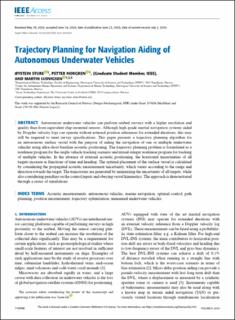| dc.contributor.author | Sture, Øystein | |
| dc.contributor.author | Norgren, Petter | |
| dc.contributor.author | Ludvigsen, Martin | |
| dc.date.accessioned | 2020-09-04T11:05:23Z | |
| dc.date.available | 2020-09-04T11:05:23Z | |
| dc.date.created | 2020-06-28T16:14:32Z | |
| dc.date.issued | 2020 | |
| dc.identifier.citation | IEEE Access. 2020, 8 116586-116604. | en_US |
| dc.identifier.issn | 2169-3536 | |
| dc.identifier.uri | https://hdl.handle.net/11250/2676413 | |
| dc.description.abstract | Autonomous underwater vehicles can perform seabed surveys with a higher resolution and quality than from equivalent ship-mounted sensors. Although high-grade inertial navigation systems aided by Doppler velocity logs can operate without external position references for extended durations, this may still be required to meet survey specifications. This paper presents a trajectory planning algorithm for an autonomous surface vessel with the purpose of aiding the navigation of one or multiple underwater vehicles using ultra-short baseline acoustic positioning. The trajectory planning problem is formulated as a nonlinear program for the single-vehicle tracking scenario and mixed-integer nonlinear program for tracking of multiple vehicles. In the absence of external acoustic positioning, the horizontal uncertainties of all targets increase as functions of time and heading. The optimal placement of the surface vessel is calculated by considering the propagated acoustic measurement uncertainty, which varies according to the range and direction towards the target. The trajectories are generated by minimizing the uncertainty of all targets, while also considering penalties on the control inputs and obeying vessel kinematics. The approach is demonstrated through a series of simulations. | en_US |
| dc.language.iso | eng | en_US |
| dc.publisher | Institute of Electrical and Electronics Engineers (IEEE) | en_US |
| dc.title | Trajectory Planning for Navigation Aiding of Autonomous Underwater Vehicles | en_US |
| dc.type | Peer reviewed | en_US |
| dc.type | Journal article | en_US |
| dc.description.version | publishedVersion | en_US |
| dc.source.pagenumber | 116586-116604 | en_US |
| dc.source.volume | 8 | en_US |
| dc.source.journal | IEEE Access | en_US |
| dc.identifier.doi | 10.1109/ACCESS.2020.3004439 | |
| dc.identifier.cristin | 1817430 | |
| dc.relation.project | Norges forskningsråd: 247626 | en_US |
| dc.relation.project | Norges forskningsråd: 276730 | en_US |
| dc.description.localcode | This work is licensed under a Creative Commons Attribution 4.0 License. For more information, see https://creativecommons.org/licenses/by/4.0/ | en_US |
| cristin.ispublished | true | |
| cristin.fulltext | original | |
| cristin.qualitycode | 1 | |
